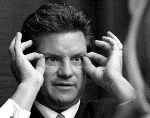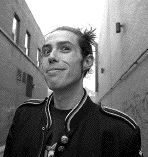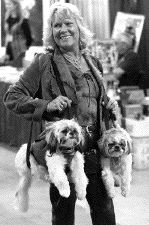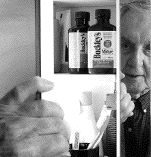Did you change your hair?
From the Sharon Dunn |
| Did you change your hair? At the anti-ageing show, doctors tell the secrets to keeping a youthful appearance |
 [Photo: Glenn Lowson, National Post] “It’s never too late to look your best” says Dr. Stephen Mulholland, director of plastic surgery at SpaMedica. Suddenly the idea of a facelift is intriguing. Maybe it’s because so many of my friends have reached the stage where they’re considering one, or should be. Not me, of course. I haven’t changed since I was 21. Or have I? “You have beautiful skin over the cheeks, but from the lower lids up you look older,” Dr. Stephen Mulholland tells me bluntly. He is one of Toronto’s leading plastic surgeons and he was one of the many professionals on hand at New You 2003, the anti-ageing show at the Convention Centre over the weekend. I was like a kid in a candy store, strolling from booth to booth, learning about botox, laser demonstrations, dermabrasian, cosmetic dentistry and all the other ways to look younger. “Your neck is fine but if you look in a mirror and do an endoscopic brow lift [this involves pulling the skin upward with your index finger pressed above your temple], you’ll see that your problem is your upper lids,” says Dr. Mulholland. “And there are bags under your eyes.” “I didn’t sleep well last night,” I say defensively. “Could be,” concedes Dr. Mulholland. “That’s why, if you came to the office, we would want to look at pictures of you when you were 25 and 35, to see what you were then and what you could be again.” “I’ve changed?” I ask. “Not everyone wants to be what they were,” he continues, ignoring my question. “If you don’t want what you were before, then we need to create the beauty that was never there.” I ask if Joan Rivers is an example of creating beauty. “She looked good four facelifts ago,” Dr. Mulholland observes. And Raquel Welch?”A beautiful facelift,” says Dr. Mulholland, “and Kim Basinger’s had a good one too,” he says, adding that Madonna, too, has “had stuff done.” He doesn’t think she looks great, but “she would look worse if she hadn’t had it done. “Indeed, he continues, what I need is what she appears to have had done: “a brow lift, upper-lid lift, cheek-and-jowl lift, lower lids tightened and less bags.” And here I thought I was looking OK when I left home this morning. Dr. Mulholland consoles me by saying, “Even younger women are having work done. Catherine Zeta-Jones has had work done to maintain her good looks.” And he adds that her husband, Michael Douglas, is an example of a man who has had a successful facelift. “But Al Pacino is an example of a bad facelift.” Continuing, he says Sylvester Stallone has had a bad facelift and Robert Redford has suffered from skin that is extremely sun-damaged. I must admit everything he is telling me sounds good, but I wouldn’t consider going under the knife for mere cosmetic reasons. “Fear is a big factor,” says Dr. Mulholland, who does 200 to 300 operations a year and tells me there’s a one in 600,000 chance of dying from the anaesthetic. And what should you expect after the procedure? “To look like hell for the first week,” he says. “By the second week, you’ll look like you were hit by a door. The third week you’ll look like you had your wisdom teeth out. By the fourth week you’ll be ready to go to the store. But you won’t want your friends to see you. When you do feel ready to confront people you know”, he says, “you should tell them you’ve lost weight or changed your hair colour.” They’ll notice something is different, but they won’t know what it is,” he promises. Mulholland says it’s common for patients to feel some level of disappointment after. “But that’s all about expectation,” he says, surprising me by adding he refuses about one in 10 patients because of unrealistic expectations. “Some women come in because they want to save their marriage. They’re considered bad candidates because they’re doing it for the wrong reasons. “He also refuses people who aren’t in good physical shape. The cost of cosmetic procedures”, he says, “ranges from about $8,000 to $25,000, which would be “from stem to stern, ear to ear, which,” he adds judiciously, “is less than a fully loaded SUV, so patients who value their car more than their face are not good candidates. And if you drive a K car, there are less expensive facelifts in the city. “So what are the right reasons for a facelift?”, I ask. “When you wake up in the morning and it affects your mood. When you look in the mirror and say, ‘Who the hell is that?’ When you feel good and look bad,” he says. “You’re a candidate now,” he tells me”. Ouch, that hurts. “Most women”, he says, “start in their early forties with brow lifts, then move on in their late forties and early fifties to cheek and jowl, and by their late fifties they’re doing their neck. Women like to do it one room at a time,” he says, adding that “it’s never too late to look your best.” And the difference between men (who represent 10% of his practice) and women? “Men come to my office in their fifties. They want a strong jaw and a dangerous face. They want that, ‘I can take you anytime’ kind of face. Women, on the other hand, want to be alluring, they want that, ‘You can have me anytime’ kind of face. Finally, I ask Dr. Mulholland, who is in his early forties and doesn’t have a single line or wrinkle, to name his plastic surgeon. He denies having had any work done. Oh, well, he’s probably just lost some weight or perhaps he’s had his hair dyed. by Sharon Dunn |









